Chris Baty's Blog, page 182
September 17, 2014
In Case of Inspiration Emergency: Write a Letter to a Character
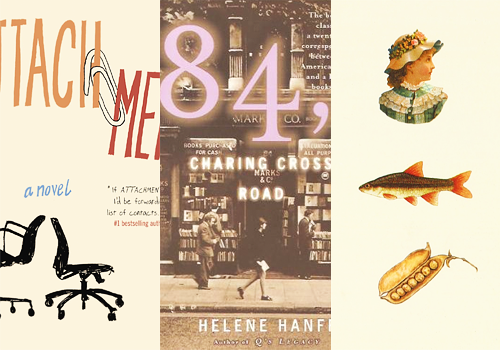
Whether you’re a planner or not, there’s one thing every writer will need as they prepare for NaNoWriMo: inspiration. We’ve challenged some of our favorite authors, and the NaNo staff to inspire you by sharing what’s inspired them… and challenging you to prepare a specific jumpstart for that inevitable idea drought:
The Inspirer: Sarah Mackey, NaNoWriMo Director of Community Engagement
The Inspiration Sources:
Ella Minnow Pea , by Mark Dunn
84, Charing Cross Road , by Helene Hanff
Attachments , by Rainbow Rowell
The Jumpstart: Write a short letter to one of your possible characters for them to respond to in November.
Why This Will Inspire You: I’ve been contemplating writing an epistolary novel for NaNoWriMo this year. For those who aren’t familiar with the concept, it’s a story written in the form of documents, usually letters. They are among my favourite type of novels to read, and although I’ve often included various letters, emails, text messages, and other documents in previous novels, I’ve never gone 100% epistolary before.
The three novels I listed above are three of my favourite epistolary novels, and they’re all incredibly different. 84, Charing Cross Road is probably the most traditionally epistolary of the three; it’s an epistolary memoir, the story of the twenty years of letters the author and a bookseller in London wrote to each other. It is a delight, and I recommend it heartily.
Attachments, by Rainbow Rowell, is not a purely epistolary novel—half of it is a third-person traditional narrative. But the epistolary sections are some of the best I’ve ever read. Rainbow Rowell’s gift for creating real, three-dimensional people is even more impressive when all she has to develop them is their email correspondence. It’s a study in character development to read this novel.
But perhaps the most impressive of these three is Ella Minnow Pea, my all-time favourite epistolary novel. It is set on a fictional island where the inhabitants worship the creator of the sentence “The quick brown fox jumps over the lazy dog.” When the letters start falling off the statue of the creator, they ban the use of those letters in real life. What does that mean for the novel? Every chapter, which consists of letters from an island resident to an off-island relative, uses fewer and fewer letters of the alphabet, until the very end when only a handful of letters remain legal.
It’s one of the most impressive pieces of writing I’ve ever encountered, and the story is hilarious and clever and well-written. It also serves as a double-dose of inspiration.
When you’re stuck writing your novel this year, think about throwing in one of Dunn’s tricks. Cover some plot territory in a letter or an email. Or, if you’re really up for a challenge, try picking a letter and writing without it for a couple of hundred words. Your pace might slow down, but your brain will wake up and you’ll find yourself looking at your writing in a totally different way. Maybe your book is 26 chapters long, and each chapter is missing a single letter. Maybe you only pull out that trick when you’re really flagging. Regardless, looking at new ways to think about language can only benefit your writing.
If you pull it off, be sure to send me an excerpt. I’d love to read it.
September 15, 2014
No Plot? No Problem! — The Joys of Writing Companions
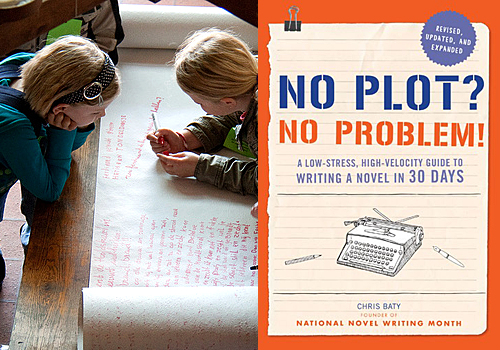
NaNoWriMo season is officially here! How can you prepare for a successful November? By planning your novel, storing up inspiration, or finding a writing partner-in-crime. Every week, we’ll have some tips from Chris Baty, and the brand-new, updated 2014 edition of his book No Plot? No Problem! Today, he profiles potential writing buddies:
Novel writing is the perfect social activity. Granted it is a social activity where no one is allowed to talk. And one where much of the pre- and post-event socializing consists of tearful laments about the deplorable state of one’s writing and the meagerness of one’s talents.
Maybe I have a strange idea of social activities, but this to me is heaven.
And a productive heaven at that. Writing with a partner (or three or four) helps all parties tap into the pool of competitive energy that forms when several people are working toward the same goal. When novelizing with someone else, you have a pacer, a motivator, and a sympathetic ear for sharing the triumphs and tragedies of your novel. It’s more productive and a lot more fun.
As you mull potential writing buddies, consider recruiting someone from the following groups:
Family Members. There’s no surer way to guarantee a productive month than challenging a family member to a 50,000-word write-off. Siblings, especially, would rather die than let a brother or sister show them up, making novel completion a fait accompli for both parties. Kids and teens can also make excellent writing companions—see the Raising Your Own Noveling Army box for tips on bringing younger family members into the novelizing fold.
The Creative Yearner. The CY grew up drawing, painting, writing, and playing music. In the past few years, though, the demands of daily life have forced these dreamers to put away their art supplies. The month of ferocious novelizing will be a structured opportunity for them to get their creative juices flowing again.
The Corked Writer. A close cousin to the CY, the CW used to write a ton but stopped when something blocked the word well. Thirty-day novels have a way of blasting right through obstructions, and the contact high from being nearby when that happens is unforgettable.
And remember: If no one in your immediate area is up for the challenge, pitch the ideas to friends and relatives in faraway towns. Or look for writing buddies in the NaNoWriMo message boards. You may not be able to novel in the same space, but you can work together on video chat or have nightly word-count check-ins via text or email.
What kind of writing partner do you prefer?
 Chris Baty accidentally founded National Novel Writing Month in 1999, and now serves as a Board Member Emeritus for NaNoWriMo. He spends his days teaching classes at Stanford University’s Writer’s Studio, giving talks, helping companies with content strategy, and endlessly revising his own novels. His quest for the perfect cup of coffee is ongoing, and will likely kill him someday.
Chris Baty accidentally founded National Novel Writing Month in 1999, and now serves as a Board Member Emeritus for NaNoWriMo. He spends his days teaching classes at Stanford University’s Writer’s Studio, giving talks, helping companies with content strategy, and endlessly revising his own novels. His quest for the perfect cup of coffee is ongoing, and will likely kill him someday.
Top photos by Flickr user hans_s, and Chronicle Books.
September 12, 2014
A Book Cover Revealed... Conviction, Collaboration, and Themes
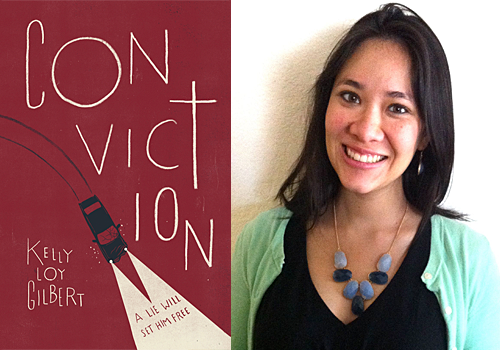
Every November, we ask 30 designers to create 30 book covers in 24 hours for novels people are writing for NaNoWriMo. The collaboration between designer and author can be incredibly inspiring. Kelly Loy Gilbert, author of the forthcoming Conviction, and NaNoWriMo associate board member shares how she, her designer, and her editor worked together to create her book cover—revealed for the first time here! (And watch out for this year’s 30 Covers, 30 Days announcement soon!)
Book covers have always felt like faces to me, and recognizing one in a bookstore or on another’s shelf is like finding a good friend in a crowded, busy place.
Ever since I sold my YA novel Conviction (releasing May 2015), I’ve quietly obsessed over what my own cover might look like. And in honor of the cover making its way into the world (for the first! time! ever!) today, my editor Laura Schreiber and cover designer Maria Elias are offering a behind-the-scenes look at the design process:
Maria Elias (designer): The design process starts with an author and editor (aka the whip-smart Laura Schreiber) who fine-tune the manuscript. Once the manuscript is ready for design, the design team (the designer with guidance from the associate art director and art director) creates cover options that represent the book, and our editors weigh in on these covers. We decide which covers to bring to our cover meetings that also include Sales and Marketing folks.
Usually we go through a few rounds of this process, until we as a team make a decision on which cover is the strongest.
Laura Schreiber (editor): This cover started out as a lot of general geeking out between me and Maria about how much we loved the book. This is such an emotional roller coaster of a book that it was hard at first to come up with any single visual representation that would reflect the story’s range. There’s a lot going on—at its heart, I think this is about a boy’s moral crisis, but it’s also an examination of faith, family, first love, and baseball.
There was no way that we could show all of that in the cover, so ultimately I wanted the cover to reflect what I considered the most fundamental element of the story: choice.
We started by narrowing down the book’s themes and storylines, and how they might be visually represented, then Maria created a number of different versions, using several different styles, that we shared in-house.
Kelly Loy Gilbert (author): What happens next on the designer’s end?
Maria (designer): Depending on the book, usually I start with a couple of ideas and themes I want to flesh out.
For Conviction some of the most evocative scenes involve cars. I went through a few rounds of photographic car covers, and some hand-drawn type-only covers, but soon we started talking about illustration. I drew some cars and headlights that weren’t quite right. It became clear that I wasn’t the right illustrator. That’s when Chris Silas Neal popped in my head. I’ve often admired Chris’s work and I knew he would create the perfect image. [ED: Chris has also contributed a fantastic cover for our 30 Covers, 30 Days project!] So I gave Chris a call and showed him an image or two that I thought would give some idea of the mood of the book.
He came back with some great images and typography that were clearly right for the book. We narrowed it down to the strongest. We made a few changes, played with color, car models, and type placement, etc. Of course we showed the team along the way and the result is the final jacket.
Kelly (author): What are the hardest and best parts of the design process?
Maria (designer): The hardest part is always before you start, because you want to do justice to the book.
The best part is harder to answer. Books are really rewarding. I love hearing readers and authors are happy. It’s rewarding hiring other creative people and collaborating with them. And it’s great seeing the books in people’s hands on the street and in bookstores.
Kelly (author): Finally, what inspires you?
Maria (designer): Good writing, art, film, and definitely people. I like to think of everyone I meet as characters with story arcs.
Kelly Loy Gilbert is the author of Conviction , about a small-town boy who is tested in every way when his father is accused of murder, coming in May from Disney-Hyperion. She is on Twitter @KellyLoyGilbert.
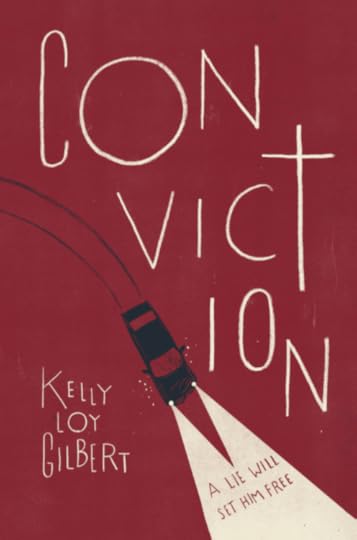
In Case of Inspiration Emergency: Devise Rules to Help Control the Fun
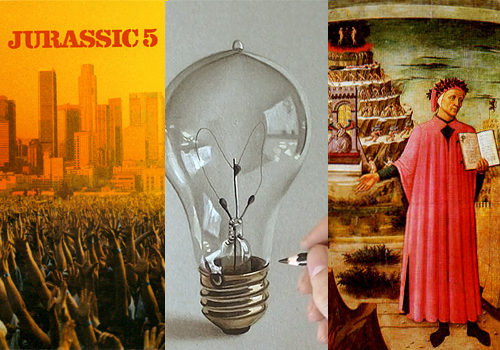
Whether you’re a planner or not, there’s one thing every writer will need as they prepare for NaNoWriMo: inspiration. We’ve challenged some of our favorite authors, and the NaNo staff to inspire you by sharing what’s inspired them… then issuing an inspiration dare:
The Contender: Dave Beck, NaNoWriMo Technical Director
The Inspiration Sources:
The Divine Comedy , Dante Alighieri
“Jurass Finish First”, Jurassic Five
The Dare: Think of three structural challenges to whip out when the going gets, well… boring.
The Case Is Made: Ask the average person to write a poem and she will likely balk at the task. Ask her to write a haiku, however, and she often becomes a willing and creative participant…
Why the sudden change? A haiku is nothing more than a poem constrained by a rigorous set of rules. But the constraints are liberating. The terrifying void of “poem” becomes a breezy and engaging puzzle when one is limited to three lines and 17 syllables.
My favorite work of literature is also one of the most ambitious poems ever written. The Divine Comedy was written by the Florentine poet Dante Alighieri in the early 14th century. I often wonder how Dante had the nerve to attempt something so audacious: 14,233 deeply spiritual lines on the cosmology of the universe, the history of Western civilization, the nature of love, sin and death, the melodrama of current-day politics, and oh-by-the-way let’s standardize the Italian language while we’re at it. It’s absurdly oversized and sublimely beautiful.
To accomplish this Dante invented a new rhyme scheme called “terza rima”. Here are the constraints:
Each stanza has three lines;
The first and last lines rhyme with the middle line of the previous stanza,
The middle line seeds the following stanza.
Typically, each stanza is a complete sentence.
Dante scrupulously cleaves to this form from Hell to Heaven. Occasionally the poetic pyrotechnics become almost laughable as he moves and elides words to fit the meter and rhyme. (Dante was quite aware of his own talent, and acknowledges as much when the narrator —Dante himself — says he’s likely to spend the most time in the “pride” section of Purgatory.)
Not much is known about Dante’s process in writing the poem, but I believe that the poetic constraints actually fueled his creativity, forcing him to think of new phrases and metaphors to complete each stanza.
In the 21st century some of the most innovative structured writing is being done by rappers. In “Jurass Finish First” by Jurassic 5, each line rhymes twice with the previous line. The first few lines echo the “ass/erse” scheme of the song’s title:
Because of cash in the purse,
guns blast in the hearse,
a vast universe
when the last is the first.
The past been a curse,
I need some aspirin to nurse.
It’s your casket in earth,
or my ass when it hurts…
As the song progresses the rhymes drift and weave like a Bach fugue, finally resolving themselves where they began. It is the group’s most structured song, and (to my mind) its most interesting.
So when you get stuck writing that novel, here’s one thing to try: give yourself some helpful structure. Free your mind by erecting a few temporary fences. Stop writing a novel and write a chapter instead. (And if that doesn’t work write a paragraph.)
Still stuck? Try writing the whole chapter without using the same adjective twice, or without using the verb “to be.” Write the entire chapter in dialog. Begin each paragraph with the letter Q. Randomly pick words from the dictionary and work them into the story. When you go back to edit later, the gems you find may surprise you.
— Dave Beck
This Will Inspire You: Rules Help Control the Fun

Whether you’re a planner or not, there’s one thing every writer will need as they prepare for NaNoWriMo: inspiration. We’ve challenged some of our favorite authors, and the NaNo staff to inspire you by sharing what’s inspired them… then issuing an inspiration dare:
The Contender: Dave Beck, NaNoWriMo Technical Director
The Inspiration Sources:
The Divine Comedy , Dante Alighieri
“Jurass Finish First”, Jurassic Five
The Dare: Think of three structural challenges to whip out when the going gets, well… boring.
The Case Is Made: Ask the average person to write a poem and she will likely balk at the task. Ask her to write a haiku, however, and she often becomes a willing and creative participant…
Why the sudden change? A haiku is nothing more than a poem constrained by a rigorous set of rules. But the constraints are liberating. The terrifying void of “poem” becomes a breezy and engaging puzzle when one is limited to three lines and 17 syllables.
My favorite work of literature is also one of the most ambitious poems ever written. The Divine Comedy was written by the Florentine poet Dante Alighieri in the early 14th century. I often wonder how Dante had the nerve to attempt something so audacious: 14,233 deeply spiritual lines on the cosmology of the universe, the history of Western civilization, the nature of love, sin and death, the melodrama of current-day politics, and oh-by-the-way let’s standardize the Italian language while we’re at it. It’s absurdly oversized and sublimely beautiful.
To accomplish this Dante invented a new rhyme scheme called “terza rima”. Here are the constraints:
Each stanza has three lines;
The first and last lines rhyme with the middle line of the previous stanza,
The middle line seeds the following stanza.
Typically, each stanza is a complete sentence.
Dante scrupulously cleaves to this form from Hell to Heaven. Occasionally the poetic pyrotechnics become almost laughable as he moves and elides words to fit the meter and rhyme. (Dante was quite aware of his own talent, and acknowledges as much when the narrator —Dante himself — says he’s likely to spend the most time in the “pride” section of Purgatory.)
Not much is known about Dante’s process in writing the poem, but I believe that the poetic constraints actually fueled his creativity, forcing him to think of new phrases and metaphors to complete each stanza.
In the 21st century some of the most innovative structured writing is being done by rappers. In “Jurass Finish First” by Jurassic 5, each line rhymes twice with the previous line. The first few lines echo the “ass/erse” scheme of the song’s title:
Because of cash in the purse,
guns blast in the hearse,
a vast universe
when the last is the first.
The past been a curse,
I need some aspirin to nurse.
It’s your casket in earth,
or my ass when it hurts…
As the song progresses the rhymes drift and weave like a Bach fugue, finally resolving themselves where they began. It is the group’s most structured song, and (to my mind) its most interesting.
So when you get stuck writing that novel, here’s one thing to try: give yourself some helpful structure. Free your mind by erecting a few temporary fences. Stop writing a novel and write a chapter instead. (And if that doesn’t work write a paragraph.)
Still stuck? Try writing the whole chapter without using the same adjective twice, or without using the verb “to be.” Write the entire chapter in dialog. Begin each paragraph with the letter Q. Randomly pick words from the dictionary and work them into the story. When you go back to edit later, the gems you find may surprise you.
— Dave Beck
September 10, 2014
No Plot? No Problem! - How to Stay Alert While Writing
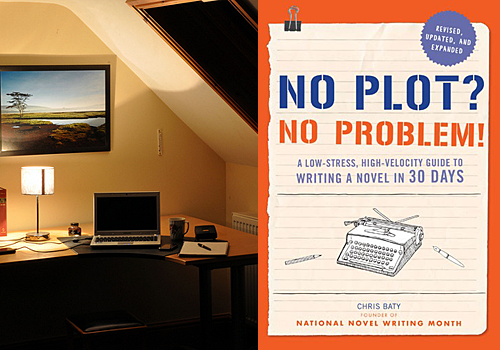
NaNoWriMo season is officially here! How can you prepare for a successful November? By planning your novel, storing up inspiration, or finding a writing partner-in-lines. Today, we’ve got some tips from Chris Baty, and the brand-new, updated 2014 edition of his book No Plot? No Problem!, on pulling off a late night of writing:
Between work, school, family, and errands, the only time many of us have to get writing done are the quiet, pre-bed hours. Writers in their teens or twenties will have no trouble handling an occasional regimen of burning the candle at both ends. For us older writers, though, all-nighters are out of the question, and we’ll need all the help we can get to keep from ruining the romantic late-night writing tableau by falling asleep at the keyboard.
Happily, there are a host of tricks you can use to turn the barren wastelands of exhausted evenings into productive writing oases. As you might expect, coffee drinkers do very well in the month-long novelizing arena, and java junkies will likely find themselves brewing up thick pots of the stuff at all hours. Green teas, along with the South American herb yerba mate, also make great coffee substitutes for those who don’t like coffee’s flavor.
For those unfortunately souls who become jittery zombies when dosed with caffeine, there are a host of equally powerful stimulants to make the brain sparkle, even in the wee hours. Some of the best include:
Fresh air: Crack a window, or, better still, go sit outside on the front steps for a few minutes. This is especially reviving if you’re novelizing in winter months. Plant lovers can drag all of their little friends into their writing room to create a low-intensity oxygen bar.
Peppermints: A NASA-funded study showed that the oils of the peppermint plant increased alertness by 30 percent and decreased fatigue by 15 percent. Peppermint tea, peppermint candies, and peppermint oil all work fine.
Sunlight: This one takes a little planning, as sunlight tends to be relatively hard to come by at 11:00 p.m. The good news is that sunlight absorbed during the day—even on cloudy days—has been shown to elevate moods long after the sun goes down.

Chris Baty accidentally founded National Novel Writing Month in 1999, and now serves as a Board Member Emeritus for NaNoWriMo. He spends his days teaching classes at Stanford University’s Writer’s Studio, giving talks, helping companies with content strategy, and endlessly revising his own novels. His quest for the perfect cup of coffee is ongoing, and will likely kill him someday.
Top photos by Flickr user El Villano, and Chronicle Books.
September 8, 2014
NaNo Prep: Giving Your Hero a Reason to Heal

NaNo Prep season is here! Whether you’re already planning your novel, searching for inspiration, or planning not to plan your novel, we’ll be providing insights, tips, and writer fuel to help you hit the ground running in November. Today, author Alan Sitomer shares how you can give your protagonists drive—and find healing:
To have a great story you must have a great hero. And to have a great hero, you must beat the crud out of them.
Totally serious. Great heroes, over the course of great stories will have been dragged through the mud physically, emotionally, spiritually and psychologically. Maybe not in that order, but it will have happened. Each hurt should be wrenching, vivid and altering (if not downright scarring).
Indeed, to become a successful writer you must love your hero and hurt your hero. Why? Because readers love it! Why do they love it? Because the more formidable the challenge, the deeper down the hero must reach in order to achieve their goal and heal.
Over the course of a good story, the reader will come to experience a couple primary hurts:
The hero’s current hurt.
A fresh hurt.
The current hurt.
Stories begin with placing your character in a setting. But this is not just a physical place; it’s also an emotional place for the character as well. Then something goes wrong. Their life either already has a problem or their life is about to undergo some sort of “trigger” incident that will open a fresh wound.
People like to get comfortable in their lives and many, many folks live by the creed, “If it ain’t broke, don’t fix it.”
Break something. It will force your hero to get off their butt and go fix it.
For example, in The Hunger Games, Katniss is a young girl who’s forced to illegally hunt in order to feed her fatherless, practically starving family. If Katniss doesn’t bring home food, her younger sister, the shining light of her life, doesn’t eat. Powerful, hurtful stuff for sure.
How about the classic novel Animal Farm? When the book opens, the oppression of mankind—the current hurt—creates a world of suffering for the animals, the protagonists of Orwell’s book.
But then, in each of the examples, what happens to our protagonists? That’s right, things get worse!
Worse? How? The reader says to themselves.
Makes it intriguing, huh?
A fresh hurt
All of us have a line in the sand. The theory of the fresh hurt is that you cross it. Take your protagonist to the point where despite the fact that they do not want to act, they must. The fresh hurt sends the hero reeling into an “enough is enough” moment.
For Katniss, her “enough is enough” moment is her belief that, “There’s no way you’re taking my sister to fight in these sick games. You want to mess with someone from my family? Well, now you’re gonna have to mess with me.”
In Animal Farm, the moment comes when the farmer gets so drunk he forgets to feed the animals. Next thing you know, enough is enough: rebellion.
All of us have a line in the sand. When a fresh hurt crosses the line and the hero can no longer sit idly by, that’s what will give your story its engine.
Good luck with your adventure.

Alan Sitomer is California’s 2007 Teacher of the Year and the founder of The Writer’s Success Academy. In addition to having been an inner-city high school English teacher and former professor in the Graduate School of Education at Loyola Marymount University, Mr. Sitomer is a nationally renowned speaker who specializes in engaging underperforming students. Additionally, Mr. Sitomer has authored 16 books to date.
September 5, 2014
Designer Q&A: Elizabeth Doyle on Your Boundless Novel
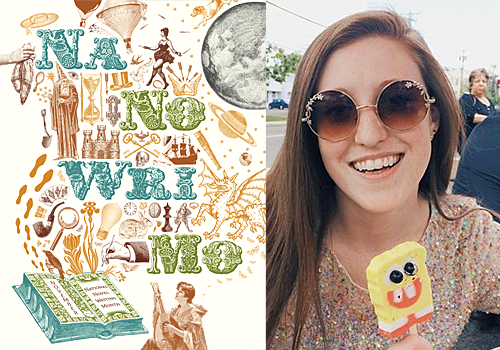
Every year, we roll out a brand new theme for NaNoWriMo, complete with a new poster, T-shirts, mugs, and more. Last year, we brought NaNo to you in retro 8-bit video game style. This year, we took it back even further, to bring you a steampunk-influenced, Victorian, anything-could-happen Boundless Novel. After all, if there’s anything we’ve learned, it’s that your imaginations are limitless. (And occupied by the occasional dragon.)
Designer Elizabeth Doyle shares her process, and how her work at Simon & Schuster and love for antique books influenced this year’s gorgeous design:
The design this year is beautiful! Will you tell us a little bit about your process for creating the poster for our “Boundless Novel”?
When I was approached to do this year’s design, I could not have been more excited. There is a special place in my heart for projects where I get to use the vintage images I’ve been collecting for years. Fairytale scenes, space adventures, mysterious characters, and fanciful typography were begging to get out of my head (and hard drive) and onto this poster.
Creating detailed collages like this takes a lot of patience and willpower. After I got the typography and book image in place, I found about 500 images I could use to tell the story of the “Boundless Novel”. I first began placing the images with the most personality on the poster, like the wizard, moon, and dragon. Once the coolest pieces found their place in the composition, the smaller images were woven in one by one. It’s so satisfying to see so many images working together to tell a story. Especially because they all came from different homes!
What are you most proud of in terms of the art you created for NaNo?
I am definitely proud of the poster the most. I love how each little section on the poster tells a tiny, whimsical story. I hope it can inspire all the NaNo-novelists!
The detailed lettering I used on the poster was actually from an 1840’s typography collection. Isn’t that amazing?! It was collected by a man named Joseph Bathazar Silvestre, who went by Silvestre the calligraphy teacher of the princes. Now that is a bad-ass title. He mainly collected unusual alphabets and hired very talented artists to engrave them.
It feels like my birthday whenever I find old typography and engraving books. A big goal of mine is to bring dusty, old images, like that beautiful type, back to life for many people to enjoy.
You’re currently working as a designer at Simon & Schuster! What do you do there? What’s your average day like?
I am a children’s book designer! I help brainstorm new book ideas, work with illustrators and artists to create lovely images and stories, and also compose the artist’s work into a printable book format.
Every book has different “wants & needs”. Thinking about how to layout a book so it tells the story in the most beautiful and comprehensive way possible is very challenging, but also very rewarding. A book is a wonderful gift and always an honor to work on. Books give the reader time: time to learn about themselves, grow with new ideas, contemplate old ideas, and so much more. Books are magic.
A little birdy has told me you’re writing and illustrating a children’s book as well! Can you tell us anything about that at all?
I wish I could tell you everything about it but I am sworn to secrecy for a few more months! I’ll give you a little sneak peak though. It’s a new take on the classic alphabet book. The art is very similar in style to the NaNo poster.
In addition to woodcut images like the ones on the poster, I am using many colorful images from old greeting cards, books, packaging, advertisements… the list goes on. Think “I Spy” meets antique-rainbow-dictionary. I probably have said too much! It comes out in July 2015 and is definitely for any age, not just children. The art will be done by November and then I will finally be able to spread the word.
I’ve also heard you love to collect antique books—what is the coolest book in your collection?
Heck yeah! Antique books are where it’s at. So much care and expertise went (and still goes) into making a book. What makes antique books the coolest is that they were all done by hand. Making the paper, setting or engraving the type, binding the book, tipping in lithographs. On top of that, the art is almost always ridiculously intricate. The ornateness of antique books makes my soul burn brighter.
It’s so hard to choose one book. What’s important to me about each book is how it came to be in my possession. So, I guess my favorite book would be the 1901 printing of The Henneberry Co.’s Elizabeth And Her German Garden by Elizabeth Von Arnim. Each page is adorned with a fantastical woodcut displaying imagery of Elizabeth’s life in her garden. Breathtaking. My mom found it for me at a town book sale. It’s a pretty rare edition—good find, Mom!
And finally, we have to ask: if you were participating in NaNoWriMo, what would your novel be about?
I’ve never even thought about writing a novel before! But if I had the chops like all you NaNoWriMo wizards out there, I would definitely write something whimsical and twisted, with non-fiction roots.
Or maybe a joint biography about Tom Waits and his wife Kathleen Brennan. They’re my favorite writers.
Elizabeth Doyle is a designer, illustrator, and author from New Jersey. She grew up on the outskirts of New York City and knew one day she would make her home there. She is currently a children’s book designer who wants to bring laughter to kids everywhere. Elizabeth is also an avid collector of oddities & antiques, WFMU fanatic, and you’ll never see her without tea in hand. Keep up with her on Instagram.
September 3, 2014
Got the Writing Blues? A 4-Step Guide to the Cure

Like falling sick with a cold, falling out of sync with what you’re writing can exhaust you. Maybe you’ve been writing novels and the only coherent parts are at the beginning. Your short story—though it’s short—actually doesn’t have conflict. The screenplay you’ve been working on is written with sparse dialogue. Still, you battle on until there comes that one blank page that leads to blank staring, and a blank head with no-idea-at-all-in-any-way of what it’s going to produce.
There is still hope! Like taking cold medicine, you can open a new Word Document and take a hearty dose of something new. (This is also when you grab some chocolate as your award for having courage.) Here are some tips for fighting the writing blahs by tackling a whole new genre or type of writing project:
Study. Yes, studying isn’t usually that interesting. But if you want to write something new and you have no idea how, finding some type of structure can help. A screenplay has a structure based on acts and page formatting; poetry has stanzas and surprising line breaks; novels have tension and character arcs that are not as smoothly-arching as a rainbow’s.
Become a copycat, not a copy editor. Finding writing inspiration can help way, way, more than you’d expect. It’ll make you want to keep writing when it’s an hour past your usual REM cycle, but don’t nitpick every single tiny, microscopic, detail to write just as well as your muse (yet).
Fracture the rules after you know them. Getting some idea of what to do/what not to do is helpful, but twisting around the rules that were “written in stone” can be liberating. It’s a way to get words written. (And it keeps you from tearing out the keys on your keyboard.)
Write. This is the very thing that NaNoWriMo encourages: writing a lot and making mistakes to fix at a later point in time. Really. Write what you want, without worrying about anything in the future. And leap off of the cliff. Wait. No. Don’t go cliff diving. Just start something new.

Irina Michaels is an aspiring novelist and screenwriter—she can be found at different places on the internet writing things other than novels and screenplays. She loves mythology and chocolate, and stacks books, having no other place to put them, on furniture that is expressly not designed to hold such weight.
Top photo by Flickr user ChicagoSage.
August 29, 2014
At 3354 Adeline: Closing Another Chapter... Changed

As Camp NaNoWriMo intern, Katharine Gripp inspired writers through leading Virtual Write-Ins, and encouraged student voices through Student Pep Talks. She says goodbye… and makes us tear up a little:
(Interested in our fall internship? Check it out!)
Saying goodbye, I’ve found, can be a little bit like writing a novel. All the basic elements are there: that awkward beginning when you search for those few elusive words that will lead the way into the heart of what you’re trying to say; the anxiety of putting those words together in a way that is both coherent and meaningful; and even, sometimes, those late nights lying awake after you’ve shared your carefully chosen words with someone else, wondering, ‘Did they really get it? Did I get across everything I wanted to say?’
With novels, luckily, things can always be re-written, in second or third (or fiftieth) drafts. However, with goodbyes, you don’t always have that luxury, and you never quite know which draft is going to be the final copy.
But I’ve also found that with both writing a novel and saying goodbye, there is always a current of excitement running underneath the sometimes overwhelming element of uncertainty—excitement for what’s coming next, for new and uncharted territory. With writing, it can often be that next idea bubbling up in your brain, waiting to break the surface and turn into another messy, magical portal to a different world. With goodbyes, the excitement often stems from the knowledge that whatever your next adventure is, you will jump into it changed and inspired by the people or places you’re saying goodbye to.
I’ve moved around a lot in my life, but somehow I never get much better at saying goodbyes (hopefully, that’s another thing that’s different from writing novels). Working in the NaNoWriMo office for the past six months has been one of the best (and most fun!) experiences I’ve had, from throwing candy and confetti at the computer during Write-Ins, to working with the young writers who shared their phenomenal Pep Talks with the NaNo community… not to mention several cutthroat games of office Uno.
Despite my inevitable sadness at leaving, I console myself with the fact that all the wonderful people here will still be close (and although I don’t really mean geographically, that’s true too: I’ll probably gate-crash more Uno games at some point in the near future—shhh). That undercurrent of bubbling excitement pushes me forward with the knowledge that, even though I won’t be sitting at this desk next week, the support of the community I’ve found here will always be with me, no matter what happens next.

Katharine Gripp hails from the exciting and well-known metropolis of Fairhope, AL. She recently graduated from Vassar College with a degree in English and a minor in Medieval and Renaissance history, which she chose to pursue mostly because of her life-long addiction to Young Adult fantasy novels. When not writing, Katharine spends most of her time dancing, hiking in the beautiful wilderness, getting paint on most of her clothes and occasionally on a canvas, more dancing, creating ridiculous costumes, and even more dancing.
Top photo by Flickr user Dolinski.
Chris Baty's Blog
- Chris Baty's profile
- 63 followers



